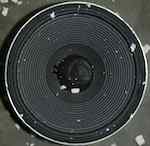I checked Your data. Your box should resonate at 35.6 Hz. I ran WinISD, selected the 2235H driver, 170 liter box volume and played a bit with the tuning: 32 Hz box resonate frequency (Your target) is a relative optimum.
The ducts have one end flanged and one end free standing. The end corrections are:
flanged: 0.85 R
free: 0.613 R
together: 1.463 R
So the effective length of each tube should be (6 + 2.93) in = 8.93 in.
Perhaps Your simple sine wave generator has a broken frequency pot?
Your picture shows that You are using a tube amplifier. These things often do have a high output impedance. And Your passive xover will have a series inductor with maybe a high resistance. The following post shows how to calculate the resulting Qt for Your driver. This will have an influence on bass response.
http://audioheritage.org/vbulletin/s...&postcount=105
Ruediger



 Reply With Quote
Reply With Quote







